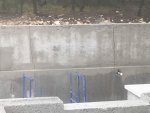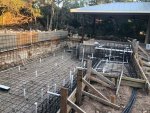Hi Pool Pros,
Have a pool under construction in Austin and have a thread on it...but wanted to start this one for the thread title to see if any experienced builders have dealt with this issue. I noticed these cracks today and informed my PB. The gunite/shotcrete was done almost two months ago. The upper portion is a three-foot wall that was formed to be above water level, for looks across back of pool and to and hold our two three-foot water shears.
I showed this pic to my future pool maintenance person who passed it to a PB he knows who said I need to send it to the national shotcrete association to make sure the proper fix is done. I told my PB who is a good guy and he believes he has it under control as he said the cracks were much smaller and only now visible because they’ve cut into them to repair them. The other PB said standard procedure is something like cutting three feet on either side back into the rebar and the re applying the gunite/shotcrete.
How concerned should I be and should I reach out to any association?
Appreciate any thoughts.
Have a pool under construction in Austin and have a thread on it...but wanted to start this one for the thread title to see if any experienced builders have dealt with this issue. I noticed these cracks today and informed my PB. The gunite/shotcrete was done almost two months ago. The upper portion is a three-foot wall that was formed to be above water level, for looks across back of pool and to and hold our two three-foot water shears.
I showed this pic to my future pool maintenance person who passed it to a PB he knows who said I need to send it to the national shotcrete association to make sure the proper fix is done. I told my PB who is a good guy and he believes he has it under control as he said the cracks were much smaller and only now visible because they’ve cut into them to repair them. The other PB said standard procedure is something like cutting three feet on either side back into the rebar and the re applying the gunite/shotcrete.
How concerned should I be and should I reach out to any association?
Appreciate any thoughts.





